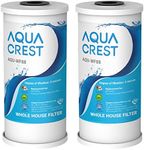Buying Guide for the Best Self Cleaning Water Cooler
Choosing a self-cleaning water cooler can make your life easier by providing clean, cold, or hot water without the hassle of frequent manual cleaning. When shopping for one, it's important to understand the main features and specifications that affect performance, convenience, and suitability for your home or office. By focusing on your daily needs and preferences, you can find a water cooler that fits seamlessly into your routine and ensures safe, fresh water at all times.Self-Cleaning TechnologySelf-cleaning technology refers to the system the cooler uses to sanitize its internal water lines and reservoir, often using methods like UV light or ozone. This feature is important because it helps prevent the buildup of bacteria, mold, and other contaminants, ensuring your water stays safe and fresh. Some coolers clean automatically on a schedule, while others require you to activate the cleaning cycle. If you want a truly hands-off experience, look for models with fully automatic cleaning. If you prefer more control, a manual activation option might suit you better. Consider how often you want to think about maintenance and choose accordingly.
Water Temperature OptionsWater coolers can offer cold, hot, and sometimes room temperature water. This is important because it determines how versatile the cooler will be for your needs, such as making tea, coffee, or simply enjoying a cold drink. Some models offer only cold and room temperature, while others include a hot water spout with safety features. If you need hot water for beverages or instant meals, choose a model with a hot water option. If you only want chilled water, a simpler model may be sufficient.
Loading Type (Top-Load vs. Bottom-Load)The loading type refers to where you place the water bottle—either on top of the unit (top-load) or in a compartment at the bottom (bottom-load). This matters for convenience and aesthetics. Top-load coolers are straightforward but require lifting heavy bottles, which can be difficult for some people. Bottom-load coolers hide the bottle and make changing it easier, as you don’t have to lift as high. If you want a cleaner look and easier bottle changes, bottom-load is a good choice. If you don’t mind lifting and want a simpler design, top-load may work for you.
Capacity and Bottle CompatibilityCapacity refers to the size of the water bottle the cooler can accommodate, usually measured in gallons or liters. This is important because it affects how often you need to replace the bottle and whether the cooler fits standard bottle sizes available in your area. Some coolers are designed for 3-gallon bottles, others for 5-gallon, and some can handle both. Think about your household or office water consumption and how often you want to change bottles, then pick a cooler that matches those needs.
Child Safety FeaturesChild safety features, especially on hot water dispensers, are important if you have young children around. These features prevent accidental dispensing of hot water, which can cause burns. Some coolers have a button or switch that must be pressed in a certain way to release hot water. If you have kids or expect children to use the cooler, make sure to choose a model with reliable safety mechanisms.
Drip Tray and Spill ManagementThe drip tray catches spills and drips from the dispenser, helping to keep your floor clean. Some trays are removable and dishwasher-safe, making them easy to clean, while others are fixed. If you want easy maintenance, look for a cooler with a removable, easy-to-clean drip tray. If spills are a concern in your space, a larger or deeper tray can be helpful.
Noise LevelNoise level refers to how much sound the cooler makes while operating, especially when cooling or heating water or during self-cleaning cycles. This is important if you plan to place the cooler in a quiet environment like a bedroom, office, or study area. Some coolers are designed to be very quiet, while others may produce noticeable hums or clicks. If noise sensitivity is a concern, look for models advertised as low-noise or check user reviews for feedback on sound levels.














